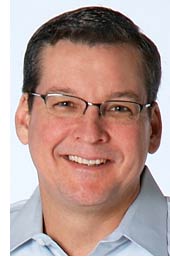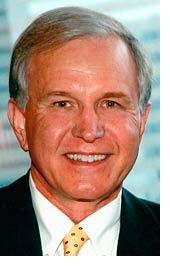College of Architecture names nine 2012 Outstanding Alumni
Pioneering designers, an entrepreneur, educator, an advocate for the landscape architecture profession and a leader in the animation industry were named 2012 outstanding alumni by Texas A&M’s College of Architecture.
The group, nominated by former students and selected for their outstanding achievements and professional leadership by a college committee, was honored at the college’s 2012 Outstanding Alumni Awards Banquet Oct. 26 in the Grand Ballroom of Texas A&M’s [Memorial Student Center] (http://www.mscc.tamu.edu/) .
Less than one percent of the college’s 15,000 plus former students have been recognized as outstanding alumni, the highest honor bestowed by the college to former students.
The 2012 College of Architecture Outstanding Alumni are: Arch Aplin III ’80, founder, owner of Buc-ee’s convenience stores; the late interior designer Melvin Hamilton ’71, senior vice president, director of design quality, ISD Inc., Gary Maler ’74 , director, Real Estate Center, Texas A&M; Scott Marble ’83, founding partner, Marble Fairbanks Architects director of integrated design, Columbia University Graduate School of Architecture; Michael Murphy ’61, retired Texas A&M professor of landscape architecture; Cleveland Turner ’73, founding principal, Turner LandArchitecture; Jim Singleton ’66, founding principal, Jim Singleton architects and Dave Walvoord ’96 , visual FX supervisor, DreamWorks Animation SKG.
 Arch Aplin III ‘80
Arch Aplin III ‘80
Founder, owner,
Buc-ee's convenience stores
Among Texas’ unique traveling attractions are its 26 [Buc-ee’s] (http://www.bucees.com/) stores, founded by Arch Aplin III ’80, that feature sparkling clean restrooms, quirky marketing and unique products such as Beaver Nuggets, peppered elk jerky, private-label peach salsa, souvenir T-shirts and bumper stickers.
With this approach, Aplin, who earned a Bachelor of Building Construction degree at Texas A&M, has created a buzz from a product category with zero excitement that’s drawing customers to his stores, said Betsy Gelb, professor of marketing at the Bauer College of Business at the University of Houston.
“If you can give consumers a little whimsy and humor and a little distraction from the long drive, why shouldn’t they go there?” she said, in a Houston Chronicle [article] (http://www.chron.com/neighborhood/pearland-news/article/More-quirky-Buc-ee-s-stores-coming-to-Texas-1602977.php) .
Believe it or not, wrote Gregg Laskoski in a [blog] (http://blog.gasbuddy.com/posts/Have-you-ever-been-to-Buc-ee-s/1715-496030-1014.aspx) on GasBuddy.com, the restrooms, adorned with artwork, are one of Buc-ee’s biggest attractions. "The bathroom was fantastic," the San Antonio Express-News quoted a 77-year old woman emerging from the women's 34-stall restroom at the Buc-ee’s in New Braunfels during its grand opening in May 2012.
After earning his degree, Aplin joined the family construction and development business for a brief time then opened his first [Buc-ee’s] (http://www.bucees.com/) in 1982.
“His growing empire of convenience stores, the largest of which is 67,000 square feet with 60 gas pumps, is a shining example of economic stimulation and job creation, employing more than 1,000 Texans, in an otherwise depressed economy,” said Larry Zuber, the Texas A&M Foundation representative who coordinates fundraising for the College of Architecture.
Aplin’s told [Mays Business Online] (http://maysbusiness.tamu.edu/) ’s Christal Houston his intention was to build the brand methodically with a goal to become the best convenience store available for service and selection.
“I can assure you, it was a slow process,” he said. “There was no wow moment, no magic pill.” He told Houston he sought a competitive advantage in every decision he made as he built the chain.
He plans to continue the same methodical pace as he continues to build in the chain in the future. Growth, he said, will be slow and organic with an eye to the company’s long-term success.
“Business is fun,” he said. “I’m having a blast. I just love it.”
 Melvin Hamilton ‘71
Melvin Hamilton ‘71
Senior vice president,
Director of design quality
ISD Inc.
* posthumous award
The late Melvin Hamilton ‘71 designed the interiors of more than 100 corporate headquarters, law firms and banking institutions throughout the U.S. and won some of the field’s most coveted awards before his death in 1992.
Hamilton earned a Bachelor of Construction Management degree in 1971, then earned a Master of Interior Space Design degree in 1973.
[Gary Boyd] (http://www.arch.tamu.edu/community/formerstudents/outstanding-alumni/past-honorees/7/) ’71 said that he still remembers meeting Hamilton on his first day of freshman design class.
“There was this young, flamboyant kid from Lamesa, Texas,” said Boyd, retired senior vice president of Parsons Corporation, in a nomination letter. “Both of us came from a farm and ranch background and we became friends.”
Hamilton joined the Houston office of ISD Inc., a Chicago-based firm, in 1978. In 1985, he was in the firm’s Chicago headquarters after a promotion to senior vice president and director of design quality, winning numerous, major design contracts for large law firms across the U.S.
In a 1992 Houston Chronicle article, Hamilton recalled how he won a commission from a prestigious Atlanta law firm.
“I knew I’d have to do more than just show my portfolio to those Georgia lawyers to get them to hire a Texan working in Chicago,” he said. He hired a private jet for the day on his corporate credit card and flew the prospective clients around the country so they could see, in person, some of his best projects.
“I got the job,” he said, “and it’s a good thing, because I probably would have lost my own job if I hadn’t!”
In 1989, Hamilton was inducted into Interior Design magazine’s Hall of Fame; in 1992 the magazine named him Designer of the Year.
“This makes him one of the few designers to receive both top national honors,” said Boyd.
That year, he collaborated with famed architect [Michael Graves] (http://archone.tamu.edu/college/news/newsletters/fall2009/stories/Graves_lecture.html) to design interiors for Walt Disney Studios’ international headquarters in Burbank, Calif. Near the end of his life won the gold medal award at NeoCon, North America’s largest commercial furnishings conference, for a line of small metal tables he designed.
 Ted Kollaja ‘84
Ted Kollaja ‘84
Principal, Gensler
In his nearly three-decade career in architecture and interior design, Ted Kollaja, principal at Gensler, a global architecture, design, planning and consulting firm, has developed a significant portfolio of large, technically complex projects and advanced workplace strategies.
Among his active projects are Encana Corporation’s new 2.2 million-square-foot [headquarters] (http://www.stagesconsultants.com/international/encana_corporate_auditorium.php) in Calgary, Devon Energy’s new 2.1 million-square-foot [facility] (http://www.hines.com/property/detail.aspx?id=2187) in Oklahoma City and ExxonMobil’s new 385-acre campus in The Woodlands, Texas. Notable past projects include Southern California Gas tower in Los Angeles and the U.S. headquarters campus for Ericsson in Plano, Texas.
“He is recognized by our general contractor firm and our peers as one of the very best architects to work with on complex projects with intense schedules,” said Jim Thompson, president of JRT Construction in Dallas. “Aside from his excellence in technical skills, he is equally respected for his fairness in resolving the inevitable issues that occur on complicated projects. Ted can calmly but firmly bring together several parties and lead the group to a successful and timely resolution.”
After earning a Bachelor of Enviromental Design degree in 1984 and a Master of Architecture degree in 1986, Kollaja began his architectural career in the Houston and Los Angeles offices of [Skidmore, Owings, and Merrill] (http://www.som.com/) .
Kollaja has also made significant contributions to the architecture profession and the greater community. He was instrumental in the development and construction of the [Dallas Center for Architecture] (http://dallascfa.com/) and served as president of the American Institute of Architects’ Dallas Chapter and the Dallas Architectural Foundation.
Kollaja has held board positions with the Greater Dallas Planning Council, the Dallas Architectural Forum, and The Dallas Downtown Parks Advisory Committee.
He also served as a contributing editor for first and second editions of Interior Graphics Standards and has taught as an adjunct professor at the Rhode Island School of Design and The University of Texas at Austin.
 Gary Maler ‘74
Gary Maler ‘74
Director,
Texas A&M Real Estate Center
Gary Maler, who earned a Master of Architecture degree at Texas A&M, has lifted the university’s [Real Estate Center] (http://recenter.tamu.edu/) to global prominence after a private-sector career spearheading some of Houston’s most notable developments.
“Gary provides unparalleled industry knowledge and energy,” said Jonathan Brinsden ‘92, Chief Operations Officer of Midway Companies. “His powerful combination of strategy and creativity make him a profound and powerful industry leader.”
A frequent public speaker on real estate issues and public policy, Maler, who has led the center since 2005, is often in contact with Texas’ top policymakers seeking his perspective and insight from the center’s research.
“Under his leadership, the center has become one of the most highly respected and trusted sources of research and information that is heavily relied on by members of the legislature, the governor’s office, state agencies and the business community,” said Susan Combs, Texas’ comptroller of public accounts.
He led the establishment of Texas A&M’s comprehensive institutional real estate asset management plan and was part of the team that developed Texas A&M’s [Research Park] (http://vpr.tamu.edu/resources/researchpark) .
Before coming to the center in 1982, Maler was an operations superintendent for commercial properties at [Friendswood Development Company] (http://friendswooddevelopment.com/) , performing market feasibility studies and helping supervise construction of large-scale, mixed-use projects including [Greenspoint] (http://www.greenspoint.org/) , [Kingwood] (http://www.kingwood.com/) and [Copperfield] (http://copperfield.org/) developments.
He also coordinated Friendswood’s special projects in other regions of the country.
 Scott Marble ‘83
Scott Marble ‘83
Founding partner
Marble Fairbanks Architects
Director of integrated design
Columbia University Graduate School of Architecture
Scott Marble, who earned a Bachelor of Environmental Design degree at Texas A&M, pioneers innovative uses of digital fabrication and unique assembly techniques, creates unique, award-winning designs for a wide range of residential, educational, institutional and commercial projects as a founding principal of [Marble Fairbanks] (http://marblefairbanks.com/) , a New York design firm.
As director of integrated design at Columbia University’s Graduate School of Architecture, Planning and Preservation, he oversees the [Columbia Building Intelligence Project] (http://www.arch.columbia.edu/c-bip) , a three-year exploration of future workflow models using parametric tools to combine the flexibility of service-based industries with the economy of scale of product-based industries.
In the 2004 book “ [Marble Fairbanks: Bootstrapping,] (http://www.amazon.com/Marble-Fairbanks-Bootstrapping-Michigan-Architecture/dp/1891197371) ” Marble examined design techniques and performance in his firm’s built and speculative work.
Marble has earned numerous awards from the New York Foundation for the Arts’ Fellowships in Architecture, the American Institute of Architects’ New York chapter and the Architectural League of New York.
“He pushes design excellence and inquiry with intelligence, sensitivity and effectiveness in practice and academia,” said San Antonio architect and educator [David F. Bogle] (http://syncrostudio.com/?page_id=2) ’83. “He has a natural and practiced ability to communicate professional issues and goals, not only to clients and architectural colleagues, but to architecture students and the greater public.”
His firm’s work has been exhibited in galleries and museums worldwide, including the Architectural Association in London, the Nara Prefectural Museum of Art in Japan and the Museum of Modern Art in New York, where his drawings are part of the museum’s permanent collection.
“Marble Fairbanks has been a mentor to small practices,” said Andrew Vrana ‘93, principal of Metalab, a firm that provides an array of services including project design, delivery and management. “We have carved out a niche as [facilitators] (http://one.arch.tamu.edu/news/2012/4/25/new-kinetic-sculpture/) helping artists to help them realize their ideas through digital design and fabrication tools, an approach he instilled in our firm.”
 Michael Murphy ‘61
Michael Murphy ‘61
Retired professor of landscape architecture
Texas A&M University
Michael Murphy ’61 was a professor and mentor to thousands of students during his extraordinary tenure at the College of Architecture, said Alan B. Colyer ’81, a former student of Murphy’s and principal at [Gensler] (http://www.gensler.com/) , a global architecture, design, planning and consulting firm. “His impact on the profession of landscape architecture is immeasurable.”
Murphy joined the Texas A&M faculty in 1969 after earning a Master of Landscape Architecture degree at the University of California, Berkeley, and retired in 2011. He earned a Bachelor of Landscape Architecture degree at Texas A&M in 1966 and a Bachelor of Science in Range Science degree at Texas A&M in 1961.
He was already integrating biophysical and human behavioral considerations in design studios in 1972, when landscape architecture was regarded primarily as an art, wrote Jim Manskey, ’79, one of Murphy’s former students, in a nomination letter. Manskey is a principal at [TBG Partners] (http://tbg-inc.com/) , a landscape architecture and planning firm.
As a result of his research, said Manskey, Murphy developed methodologies emphasizing design decision making based on the application of evidence-based knowledge, emphasizing landscapes as process, rather than the traditional view of landscapes as places.
“When many of us, his former students, graduated and engaged in professional practice we learned to deeply appreciate his long-lasting influence on our professional lives by his consistently seeking higher standards from students through his thorough knowledge of landscape architecture,” said Manskey.
Murphy has also been a leader in internationalizing landscape architecture education, said Manskey.
During a leave of absence from Texas A&M in 1986-88, as a visiting professor at the University of Pretoria in South Africa, Murphy formed a new Department of Landscape Architecture and a curriculum at the university.
“He is one of relatively few educators in our profession who has ventured abroad to establish landscape architecture programs,” said Manskey. “His contributions to international education in landscape architecture are especially valuable and relevant in an increasingly global society,” said Manskey.
Among Murphy’s many leadership roles at the college was a 1989-91 term as head of the Department of Landscape Architecture and a 2001-02 post as the coordinator of the Bachelor of Landscape Architecture program.
Murphy has written or co-authored numerous books and articles including " [Landscape Architecture Theory,] (http://www.amazon.com/Landscape-Architecture-Theory-Evolving-Thought/dp/1577663578) " Waveland Press, 2005; "The Changing Nature of Landscape Architectural Practice: the South African Experience," Journal of Architecture and Planning Research, 2002; "The Emerging Nature of Landscape Architecture in South Africa," International Federation of Landscape Architects’ 2001 Yearbook; “Landscape Architecture 2000: Curriculum Guide for Landscape Architecture Education in South Africa,” Department of Architecture and Landscape Architecture, University of Pretoria, Republic of South Africa, 1999.
 Cleveland Turner ‘76
Cleveland Turner ‘76
Founding principal
Turner LandArchitecture
Cleveland Turner ’76 has led state and national efforts to bolster licensing and legal registration requirements of landscape architects throughout his five-decade career.
“Few of our former students have exemplified the consistent, recognized leadership and commitment to the profession as Cleve has,” said Tom Woodfin, former assistant head of Texas A&M’s
[Department of Landscape Architecture and Urban Planning]
(http://laup.arch.tamu.edu/)
.
As a member of the Texas [chapter] (http://texasasla.org/) of the American Society of Landscape Architects, Turner led a drive to add landscape architects to Texas’ Professional Services Procurement Act, a list of professions hired by state agencies for professional consulting. “Their inclusion in the PSPA has been critical, making the profession’s expertise available on state-funded projects,” said Woodfin, who heads the Division of Landscape Architecture at the University of Oklahoma.
Turner also helped lead the effort to include the profession in the Texas Registration Law when it was upgraded from a title to a practice act, meaning that practitioners included in the law are required to have a license instead of just a title to legally practice.
He was instrumental in implementing a uniform system of licensure for landscape architects across the U.S. as the national president of the [Council of Landscape Architecture Registration Boards] (https://www.clarb.org/Pages/default.aspx) and increased the number of regional testing centers throughout the U.S. and Canada.
“Each of the groups in which he has held roles have been transformed by his vision and organizational skills,” said Woodfin.
He is serving a five-year term on Texas A&M’s Landscape Architecture and Urban Planning [Professional Advisory Board] (http://laup.arch.tamu.edu/about/advisory-board/) , working with department faculty, staff and students to create a bridge between the educational and professional phases of a landscape architect’s career.
Turner, whose firm specializes in site design on projects ranging from university campus planning to small entry courtyards, earned a Bachelor of Science in Landscape Architecture degree in 1976 and a Bachelor of Arts in Pre-Law/Economics in 1973.
 Jim Singleton ‘66
Jim Singleton ‘66
Founding principal
Jim Singleton architects
Since establishing the [firm] (http://www.jsarchitects.com/) that bears his name in Bryan in 1998, Jim Singleton, who earned bachelor’s degrees in architecture and architectural construction in 1968, has earned numerous design awards from the [Texas Association of School Administrators and School Boards] (http://www.tasanet.org/) for his new or renovated educational buildings and athletic facilities.
Singleton’s practice includes medical buildings, banks, office buildings, restaurants and shopping centers while specializing in educational buildings of all sizes and budgets, with more than 200 designs built in more than 90 school districts.
“His work in school design is diverse and amazing, with frequently published architectural works that are extraordinarily significant,” said John Only Greer, professor emeritus of architecture.
Singleton attended Texas A&M on a football scholarship, eventually became the team’s starting center, then served as a U.S. Army helicopter pilot in the Vietnam War after earning a commission as a second lieutenant.
After returning from military service he began his career as a professional architect in Dallas then practiced in Longview and Irving, Texas.
His firm’s projects include the ,a href="http://acbv.org/">Arts Council of Brazos Valley, the [Texas A&M Sports Museum] (http://www.aggieathletics.com/ViewArticle.dbml?DB_OEM_ID=27300&ATCLID=205237905) , the [Brazos County Expo Complex] (http://www.brazoscountyexpo.com/) and pro bono projects such as the [Twin City Mission] (http://www.twincitymission.org/) , the [African-American Heritage Museum] (http://brazosvalleyaam.org/) , [Chabad House, the Victory Family Substance Abuse Center and a new ] (http://www.jewishaggies.com/) [high school] (http://209.189.226.235/schools/081504hearnehs.php) in Hearne, Texas, converted from an abandoned Wal-Mart.
Singleton helped lead an effort organizing a volunteer consortium of architects and engineers to save downtown Bryan’s iconic [Queen Theater] (http://downtownbryan.com/blog/queen/) .
“Jim and his wife Stephanie Sales are outstanding members of the Bryan/College Station community and involved in numerous charities and cultural organizations,” said Harold L. Adams ’61 in a nomination letter.
They were recognized for their leadership in 2010 by the [Community Foundation of the Brazos Valley] (http://www.cfbv.org/) .
 Dave Walvoord ‘96
Dave Walvoord ‘96
Visual FX supervisor
DreamWorks Animation SKG
In addition to being a major contributor to many of today’s blockbuster animated movies, Dave Walvoord ‘96, a visual FX supervisor at [DreamWorks Animation SKG] (http://www.dreamworksanimation.com/) who earned a Master of Visualization degree in 1996, still finds time to help to students at the Department of Visualization.
Walvoord, who earned a Master of Science in Visualization degree in 1996, is currently working on “ [How to Train Your Dragon 2,] (http://www.imdb.com/title/tt1646971/) ” scheduled for a June 2014 release.
“I am continually amazed that an individual whose work week can exceed 80-90 hours can find time to lend guidance to our students and programs here at Texas A&M,” said Ann McNamara, assistant professor of visualization.
Walvoord, who helped lead the department’s rigorous summer industry course in 2009, was promoted to his current post after serving as workflow director for look and lighting at DreamWorks; before that, he was the digital effects supervisor and head of lighting for “ [Kung Fu Panda 2,] (http://www.kungfupanda.com/) ” which earned a 2012 Best Animated Feature Oscar nomination.
Early in his career, Walvoord was a digital effects supervisor at Blue Sky Studios, where he helped create “ [Bunny,] (http://www.youtube.com/watch?v=Gzv6WAlpENA) ” which won an Oscar in 1999 in the Best Animated Short Film category.
“The film was considered revolutionary in its use of a character generated lighting technique called ‘radiosity,’” said Marilyn Friedman, head of outreach at DreamWorks. “The film still holds up today.”
He joined DreamWorks in time to work on the Oscar-nominated “Shark Tale,” said Friedman. “He built a CG lighting pipeline from scratch … no small task.”
He was the character generator supervisor for “Kung Fu Panda,” “Madagascar: Escape 2 Africa,” “Over the Hedge” and the Academy Award-nominated “Shark Tale.”
Previous post
Next Post
Tags
- architecture
- building a better texas
- class acts
- construction science
- entrepreneurship
- events
- fabrication
- feature
- global college
- honors
- interdisciplinary
- landscape architecture & urban planning
- rss
- visualization
Related Posts

13 outstanding alums share how college aided their success
College names six outstanding alumni

College honors outstanding alumni at annual ceremony

Former students create four new endowed positions
Follow Us
Facebook Twitter Vimeo Youtube Flickr RSS
Recent Posts

Planning prof heads study of disaster housing aid

A message from the dean

Former student remembered as expert planner

Leading educator named new head of Architecture Dept.








_thumbnail_small.png)
